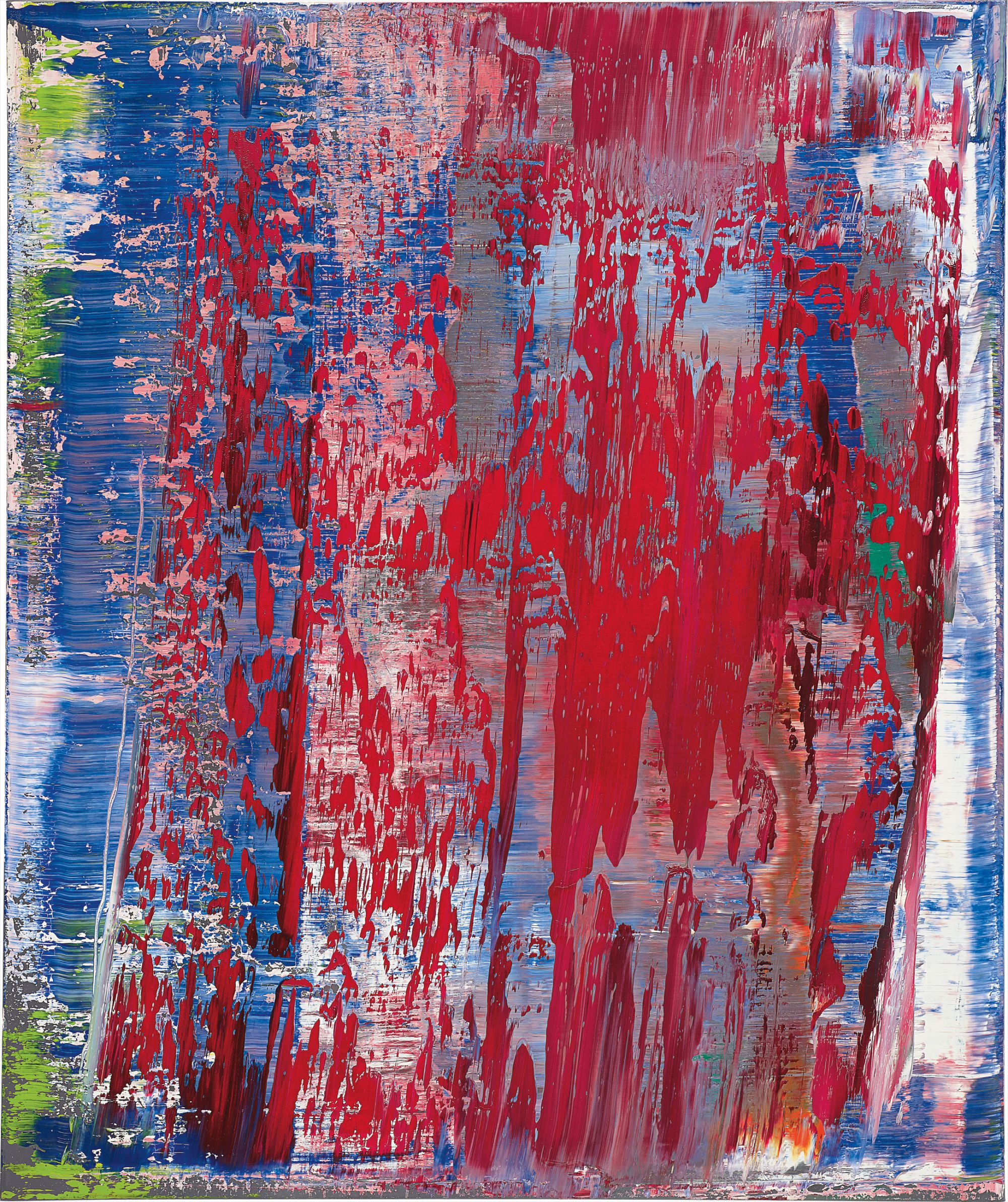

10
Gerhard Richter
Abstraktes Bild (720-2)
Full-Cataloguing
Abstraktes Bild (720-2) is a domestically scaled painting from a seminal moment in Richter’s career. Coming after his first major touring retrospective exhibition in 1986 but before his fullest retrospective exhibition to date in 1993, Abstraktes Bild sits squarely within a momentous period in his oeuvre.
The viewer is immediately struck by an intense veil of saturated red, which coats the composition like Chinese red lacquer. Deep, entrancing, and invigorating, the matador-red summons the viewer to dive into illusionistic space within the composition. Beneath this scrim lies an abstracted landscape replete with washes of sky, or is it ocean, blue, sandy pinks, spring vegetal greens, crystalline cloud whites and earthen browns. Harkening back to his earlier landscapes, Richter goes beyond those blurred photo-realistic compositions and creates an alternate visual universe. “Almost all the abstract paintings show scenarios, surroundings and landscapes that don't exist, but they create the impression that they could exit. As though they were photographs of scenarios and regions that had never yet been seen." (Gerhard Richter, “I Have Nothing to Say and I'm Saying It: Conversations between Gerhard Richter and Nicholas Serota,” Gerhard Richter Panorama, exh. cat., London, 2011, p. 19)
Richter’s paintings function as windowed layers of color, each subtly announcing its presence while the viewer peers through the enlivened colors that lay just beyond–mise en abyme. “With abstract painting we created for ourselves a better possibility of approaching what is nonvisual and incomprehensible, because it portrays nothing directly visually, with all the means available to art. Used to recognizing something real in pictures, we rightly refuse to regard only colour (in all its multiplicity) as what has been made visible and instead involve ourselves in seeing the nonvisual, that which hitherto had never been seen and that is not visible…Thus paintings are all the better, the more beautiful, intelligent, crazy and extreme, the more clearly perceptible and the less decipherable metaphors they are for this incomprehensible reality. Art is the highest form of hope.” (Gerhard Richter in, Documenta 7, Kassel, exh. cat., 1982, p.119)
Richter achieves each abstract picture through a uniquely restrained process, and the harmony of the present lot glows with mesmerizing abandon. Hints of lucid green, cherry blossom pink, and slate grey poke through a secondary layered veil of royal blue and brilliant white. Delicate in its translucence, it is tucked beneath the overarching wash of red masking the canvas. The kaleidoscopic surface both reveals and conceals a myriad of layers, colors and illusions. The liquid surface of the canvas, applied in waves of viscous pigment, belies a view of some unknown landscape, spotted with withering rays from the setting sun. Richter’s rhythm of painting on the canvas gives way to inherent movement in the picture.
Abstraktes Bild (720-2) is a stunning example of Richter’s success in the re-interpretation of image and the re-evaluation of its potential. In his exploration into the limits of painting, pushing the boundaries of expression and depiction, he encourages the viewer to reflect this originality in their perception of his works. The audience is asked to follow the artist’s guidance; pursuing his motions of impulsive revision, incorporation and amalgamation to reach an unexpected yet unified result.“I do not pursue any particular intentions, system, or direction,” Richter says. “I do not have a programme, a style, a course to follow...I like things that are indeterminate and boundless, and I like persistent uncertainty….Now that we do not have priests and philosophers any more, artists are the most important people in the world. That is the only thing that interests me.”
Gerhard Richter
German | 1932Powerhouse painter Gerhard Richter has been a key player in defining the formal and ideological agenda for painting in contemporary art. His instantaneously recognizable canvases literally and figuratively blur the lines of representation and abstraction. Uninterested in classification, Richter skates between unorthodoxy and realism, much to the delight of institutions and the market alike.
Richter's color palette of potent hues is all substance and "no style," in the artist's own words. From career start in 1962, Richter developed both his photorealist and abstracted languages side-by-side, producing voraciously and evolving his artistic style in short intervals. Richter's illusory paintings find themselves on the walls of the world's most revered museums—for instance, London’s Tate Modern displays the Cage (1) – (6), 2006 paintings that were named after experimental composer John Cage and that inspired the balletic 'Rambert Event' hosted by Phillips Berkeley Square in 2016.